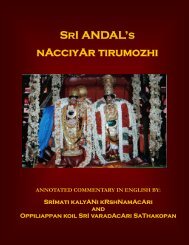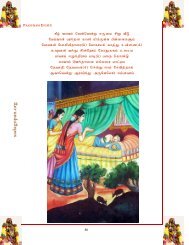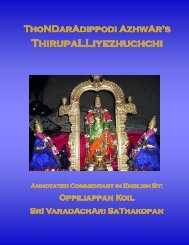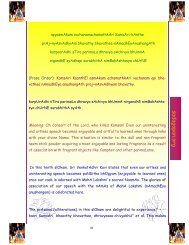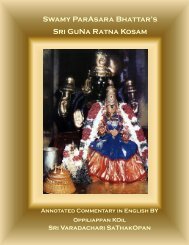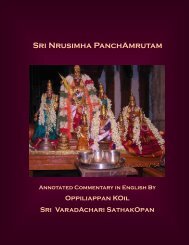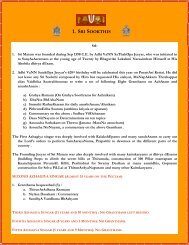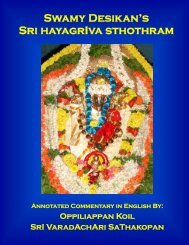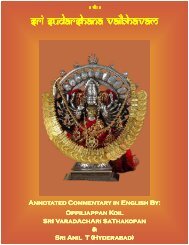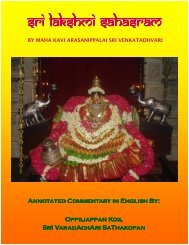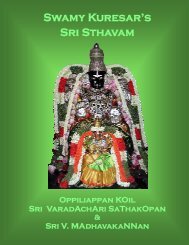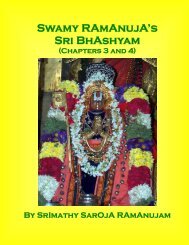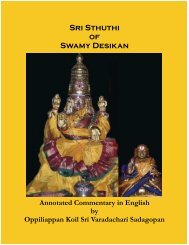Manthra Pushpam Manthra Pushpam - Sundarasimham
Manthra Pushpam Manthra Pushpam - Sundarasimham
Manthra Pushpam Manthra Pushpam - Sundarasimham
Create successful ePaper yourself
Turn your PDF publications into a flip-book with our unique Google optimized e-Paper software.
<strong>Manthra</strong> <strong>Pushpam</strong><br />
Annotated Commentary in English by<br />
Oppiliappan KOIl<br />
Sri VaradAchAri SathakOpan
sadagopan.org
MANTRA PUSHPAM<br />
॥ म�प� ु ं ॥<br />
PREFACE<br />
Mantra <strong>Pushpam</strong> (MP) is part of the Surya Namaskara Prasnam section of The<br />
Taittiriya Aranyakam. This Prasnam (Vedic Lesson) is also known as Arunopanishad<br />
by Sri Vidya Worshippers.<br />
There are 32 Anuvakas (Sections) in the Surya Namaskara Prasnam. The number of<br />
Panchasats (Individual Mantras) in this Prasnam adds up to 130. The eighth Anuvaka<br />
is a prelude to the Mantra <strong>Pushpam</strong> that is housed in the 22nd Anuvakam.<br />
The Anuvakams preceding the eighth deal with the measures of time. The eighth<br />
Anuvakam starts off by stating that all of the units of “Time” enter into “Water” which<br />
in turn enters into “Agni”, which ultimately merges with the energy of “Surya”. Eight<br />
forms of Agnis are then described.<br />
In the 22nd anuvaka dealing with mantra pushpam, “water” is recognized as the most<br />
fundamental of “elements”. The relationship between “water” and moon, agni, surya,<br />
vayu and stars is described and saluted. At the end of this anuvaka, the reciter<br />
visualizes the entire world as floating in the immensity of “water”. The mantra<br />
pushpam rks are linked with the most sacred aruna ketukam ritual.<br />
There are 12 panchasata (individual mantra/rks) in the 22nd anuvakam. I will now<br />
attempt to translate these mantras.<br />
1<br />
sadagopan.org
sadagopan.org<br />
INTRODUCTION<br />
It gives me great pleasure to attempt a translation of the majestic and marvelous<br />
mantras of Mantra <strong>Pushpam</strong>. The effort to translate this extraordinary conception of<br />
the centrality of “Aapaa:” is equivalent to describing the wind-blown fragrance of a<br />
divine flower. May this meager attempt be blessed by the Veda Purushan invoked by<br />
the Rks of Purusha, NarayaNa and VishNu Sookthams !<br />
Veda Purushan<br />
The mantras of Mantra <strong>Pushpam</strong> are part of the Surya Namaskara Prasnam of the<br />
Taittiriya Aaranyakam. There are 32 anuvaakaas (sections) in Surya Namaskara<br />
Prasnam. The eighth anuvaakam is a prelude to the concepts enshrined in the text of<br />
Mantra <strong>Pushpam</strong> that we find as the twenty second anuvaakam of Surya Namaskara<br />
Prasnam . The twenty ninth anuvaakam of Maha NarayanOpanishad of KrishNa Yajur<br />
Vedam is another excellent reference to the subject matter of Mantra <strong>Pushpam</strong>.<br />
The anuvaakams preceding the eighth of Surya Namaskara Prasnam deal with the<br />
measures of TIME. The eighth anuvaakam starts off by stating that all of the units of<br />
TIME enter in to WATER, which in turn enters into AGNI, which ultimately merges<br />
2
with the energy of Surya Murthy at whose center is Sriman Narayana. The eight forms<br />
of Agni merging as one with Surya Murthy is also covered in this anuvaakam.<br />
The 22nd anuvaakam celebrated in Bhagavad AarAdhanam daily deals with WATER as<br />
the most fundamental of “ELEMENTS”. The relationship between WATER and<br />
MOON, AGNI, SURYA, VAYU, STARS and TIME are described and celebrated here.<br />
The Mantra Drishtaa visualizes the entire world as floating in the immensity of<br />
WATER. The Mantra Pushpa Rks are linked with the most sacred aruNa kethukam<br />
rites. There are 12 panchasats (individual mantrAs) in this anuvAkam.<br />
MAHAA NAARAYANOPANISHAD: TWENTY NINTH ANUVAAKAM<br />
The above anuvaakam summarizes the thoughts that are elaborated in the Mantra<br />
<strong>Pushpam</strong>. Hence we will study this anuvaakam first. The text of the AnuvAkam is as<br />
follows:<br />
aapOHO vaa idhagum sarvam viswaa bhuthaanyApa: prANaa<br />
vaa aapa: pasava aapOannamApOamrutamApa; samradApO<br />
viradApa: svarAdApaschandhAgum syApO jyothigumshApO<br />
yajugumshyApa: satyamApa: sarvA devathA aapO bhur bhuva: suvarApa Om II<br />
Swami Vimalanandha's excellent translation following that of SayanA and<br />
BhattabhAskara is provided below:<br />
“Verily all this is water. All the created beings are water. The vital breaths in the body<br />
are water. Quadrupeds are water. Edible crops are water. Ambrosia is water. Samraat is<br />
water. Viraat is water. Svaraat is water. The metres are water. The luminaries are water.<br />
Vedic formulas are water. Truth is water. All deities are water. The three worlds<br />
denoted by bhuh: bhuvaha: and suvaha: are water. The source of all these is the<br />
supreme denoted by the syllable om.”<br />
Swami Vimalanda points out here that the Para Brahman is eulogized as WATER<br />
(aapa:). He is resplendent and multifaceted effulgence is referred to in this rk as<br />
Samraat (perpetually shining), Viraat (manifoldly shining) and Svaraat (self-luminous)<br />
according to Bhattabhaskara.<br />
Sayana interprets Saamrat as “SuthrAtmA HiraNyagarbha:”, Viraat as the<br />
“BrahmANda dEha Purusha:” visualized by the Purusha Sooktham. Svaraat is<br />
interpreted by Sayana as “avyAkruthAbhimAni Iswara:”. Sayana concludes with a<br />
reference to the revelatory statement of this rk as “apAm mula KaaraNam PraNava<br />
Prathipadhyam Brahmaiva”. The source of all these (described in this rk such as vital<br />
3<br />
sadagopan.org
sadagopan.org<br />
breaths, the three worlds et al.,) is the Supreme, denoted by the syllable OM.<br />
This then is an apt introduction to the thoughts elaborated in the Mantra <strong>Pushpam</strong> rks.<br />
SEQUEL TO MANTRA PUSHPAM: 8TH ANUVAAKAM<br />
In the previous section associated with MahAnArAyaNOpanishad, we were instructed<br />
that the source of the water principle is the syllable OM denoting the self luminous<br />
Purusha. Another passage of MahAnArayaNOpanishad explains further how Parama<br />
Purusha created the Water and for what purpose and how water serves as the central<br />
principle. That portion of the Upanishad is as follows:<br />
Ardha maasaa maasaam ruthava:<br />
samvatsarasccha kalpanthaam i<br />
sa aapa: pradhudeh ubeh imeh<br />
antharksham atho suv a: ii<br />
Here the ancient Vedic teaching pertaining to the Parama Purusha being the source<br />
and support of all the principles and objects of the Universe is revealed. This passage<br />
states that the Smallest unit of time (Nimisha/time taken to wink one's eyes) to the<br />
largest (Samvatsara /an Year) were born from this self luminous Purusha. None of the<br />
units of time are thus permanent or independent. Then the Upanishad goes on to state<br />
that He milked water (Aapa:) and the other two -viz., the firmament (Antharksham)<br />
and the heaven (suva:). The purpose of His milking these triad implies that they were<br />
generated by the Purusha for “the sustenance and enjoyment of the transmigrating<br />
souls through the agency of time on the earth and in the firmament and in heaven.”<br />
With the introduction provided by the above mantram of the Upanishad, we can now<br />
focus on the 8th anuvaakam of the Surya Namaskara Prasnam serving as a sequel to<br />
the Mantra <strong>Pushpam</strong> passages housed in the 22nd Anuvaakam of the Surya Namaskara<br />
Prasnam . The relevant passage of the 8th anuvaakam starts off asking the following<br />
questions:<br />
Where does this cloud enter and rest? Where does the assembly of time known as the<br />
year (Samvarsaram) reach laya? Where does the day find its resting place? O Lord!<br />
What about the night? Where do the months, pakshas (half months), muhurthaas and<br />
Nimishaas seek as the place of merging? Where do the sources of water go, when the<br />
ponds and rivers dry up? What is the power principle behind these phenomena? Now<br />
the Upanishad answers the above questions and states that time and its units enter the<br />
water principle. Latter in turn enter and merge with the Lord known as Surya<br />
NaaraayaNan. That powerful and universal controller absorbs the water and the time<br />
4
that is embedded in it and in the next cycle generates them again. This revelation<br />
provides the sequel to the relationships described in detail by the different mantras of<br />
the Mantra <strong>Pushpam</strong> that we use every day in Bhagavad AarAdhanams.<br />
TWENTY SECOND ANUVAAKAM & MANTRA PUSHPAM<br />
The recitation of the Mantra <strong>Pushpam</strong> has a majestic and sonorous effect that is almost<br />
mesmerizing. There are 12 mantras in the Mantra <strong>Pushpam</strong> housed in the 22nd<br />
Anuvaakam.. The first set includes the panchaasats (individual mantrams) 78 to 84.<br />
The second set covers the two panchaasats from 85 to 86. The second section is<br />
connected to the yagam known as AaruNa Kethuka sayanam (AKS). The third and<br />
final section consists of three mantras from 87 to 89and is also associated with the AKS.<br />
We shall attempt to understand the meanings of the three sections.<br />
The mantras of the first section (Rks 78-84) instruct us that Water is the aadhaaram<br />
(base or supporting principle) and Aadheyam (containing principle) for all units of time<br />
and created beings as well as vital breaths, edible crops, truth and Vedic meters as<br />
indicated by the twenty ninth anuvaakam of Maha NarayaNOpanishad. These Rks<br />
declare that the person who meditates on Jalam or Aapa: as Sarva Devathaa Svarupam<br />
is bound to gain all auspicious fruits. Such a declaration finds its echo in the Sandhyaa<br />
Vandana Mantram starting with:<br />
“Aapohishtaa mayoh bhuvasthaa na urjeh dhadhatana --- aapoh janayathaa cha na:”<br />
(Meaning): “O waters, verily You are bliss-conferring. being such, grant us food, and<br />
great and beautiful insight (of the Supreme Truth). Further make us in this very life<br />
participants of that joy of Yours, which is most auspicious, just like fond mothers (who<br />
nurse their darlings with nourishment). May we attain to that satisfactory abode of<br />
Yours, which You are pleased to grant us. Generate for us also the waters of life and<br />
pleasures on earth (during our sojourn here).”<br />
The aboveTaittiriya Samhita rk captures the spirit of the elevation of Aapa: as the Sarva<br />
Deva Svarupa principle known as Jalaabhimaani Devathaa. For the Jnanis, water is not<br />
the thirst quenching and body cleansing element, but has divinity implicit in it.<br />
MANTRA PUSHPAM RKS & THEIR MEANINGS<br />
PANCHASAT 78<br />
yOapAm pushpam veda I<br />
pushpavAn prajAvAn pasumAn bavathi I<br />
chandramA vaa apAm pushpam I<br />
pushpavAn prajAvAn pasumAn bavathi I<br />
5<br />
sadagopan.org
sadagopan.org<br />
ya yevam veda I yOpAmAyathanam veda I<br />
aayathanavAn bavathi I<br />
agnirvaa apaamaayathanam I<br />
aayathanavAn bavathi I<br />
yOagnerAyathanam veda II<br />
Here the two-way relationship between the Moon and Waters (Aapa:) is explored. The<br />
mantram states: “One who understands the nature of the flower of the waters becomes<br />
blessed with flowers, good progeny, abundant cows and cattle. Moon is indeed the<br />
flower of waters (Chandramaa vaa apAm pushpam).”<br />
Here the reference is to the birth of the Moon, when the “waters” of the milky ocean<br />
were churned by BhagavAn. The moon rose like a lotus flower from those waters.<br />
Hence the Moon's originating place, abode, base is the waters. Therefore Aapa: is the<br />
Aayathanam (the abode) for the Moon. Water has another relationship to the Moon. It<br />
arises from the cool rays of the Moon. Hence, the Moon serves as the Aayathanam for<br />
the waters. The Rk therefore declares “ChandramA vaa ApaamAyathanamI aapO vai<br />
Chandramasa Aayathanam”. Thus Water is the Aadharam and Aadheyam for the<br />
Moon.<br />
The relationship between the Moon, Heavens, firmament and waters and their<br />
directing force PraNava svarupi, the Supreme Purusha of Purusha Suktham has been<br />
alluded to in the earlier section. Many other Vedic passages dwell on this important<br />
relationship. For example, Yajur Veda manthram (XXIII--59& 60) asks a question on<br />
this subject The question is:<br />
“Who knoweth the paramount Lord of this World? Who knoweth the heaven, the earth<br />
and the wide space between them? Who knoweth the creator of the mighty Sun? Who<br />
knoweth the Moon, and whence she was generated?”<br />
The answer in the next mantram is:<br />
Vedhahamasya bhuvanasya naabhim veda<br />
dhyaavaa pruthvee antharksham<br />
veda suryasya bruhatho janithramatho<br />
veda chandramasam yatojaa:<br />
“O Questioner! I know the paramount Lord of this World. I know the Heaven, the<br />
earth and the wide space between them. I know the efficient and physical cause of the<br />
mighty Sun. I know the Moon and her creator.”<br />
In another mantram (Yajur Vedam VII-- 16), the relationship between the Moon and<br />
the waters, the subject of the first panchasat of Mantra <strong>Pushpam</strong> is hinted. Veda<br />
6
Purusha declares – “I fix in its orbit, in the midst of spacious regions, this beautiful<br />
Moon that covers the luminous stars, and is linked with the Sun and the Waters that it<br />
attracts”.<br />
Two Samans from Sama Veda pay homage to the interdependence between the<br />
Purusha and the created entities such as Water, Air, Agni, Sun, Earth, Heaven and<br />
firmament. The first is from Aranya KhAnda (Decade V-3). This is the famous<br />
mantram:<br />
Chitram devaanaamudhagaadhaneekam<br />
chakshurmitrasya vrunasyaagneh -i<br />
aapraa dhyaavaa pruthvee antharkshagum<br />
surya aatmaa jagathastasthushasccha -ii<br />
“God is wonderful and powerful amongst all the forces of nature and learned persons.<br />
He is the manifestor of air, water and fire. He pervades the Sun, Earth and atmosphere.<br />
He is the creator and sustainer of all that moveth and moveth not.” The relation<br />
between Aapa:, Agni, Vaayu, Sun, Moon, Stars and Time and Purusha, the subject<br />
matter of the mantrams of Mantra <strong>Pushpam</strong>, is covered here.<br />
Yet another (Uttaraarchika) Saman talks specifically about the relationship between<br />
Aapa: and the blessings arising from the true understanding of the Sarva Devatha<br />
Svarupam of the waters. That Saman is the 1839th Saman:<br />
Tasmaa aram gamaama voh yasya kshayaaya<br />
jinvatha i aapoh janayathaa cha na: ii<br />
“O Waters, for the removal of which impurity ye impel us, for the removal of the same<br />
we speedily go unto ye. Give us children, who make the right use of water.” The<br />
suggestion is that those, who use the water correctly and understand its significance<br />
would become “PushpavAn, PrajAvAn and PasumAn.”<br />
One verse from Atharva Veda (Anuvaka 5- hymn XX!-2) refers to the relation between<br />
the Agni and water and states: “ All fires that are in Water (Vadavaanalam in the Ocean,<br />
lightning in Clouds, digestive fire found in humans, ripening fire found in herbs and<br />
plants) -- may all these fires be put to proper use”.<br />
The relation between Agni and Water is the topic of the first mantram of Mantra<br />
<strong>Pushpam</strong><br />
Agnirvaa apaam aayathanam I<br />
aayathanavaan bavathi I<br />
yOagneraayathanam veda I<br />
7<br />
sadagopan.org
sadagopan.org<br />
In the order of creation, Upanishad states “Agneraapa:”.<br />
Agni is thus the receptacle of Jalam. From Jalam, the fire under the ocean (Vadavaagni)<br />
is produced. Hence as in the case of Chandran, Agni also has a dual relation<br />
(Aadharam and Aadheyam).<br />
In a similar vein, Vayu, Surya, Stars, Rain and Time have the dual relationship to Aapa:<br />
“Kaalaa Apsu Nivasanteh I Aapaa Suryeh Samaahitaa: I”<br />
The all encompassing nature of Aapa: in the spirit of Maha Narayana Upanishad<br />
Vakhyam (AapOvaa Idagum Sarvam, Sarva Bhoothaanyaapa: -- Bhur bhuva suvaraapa<br />
OM), the 84th panchasat visualizes the entire Universe as a gigantic ship floating on<br />
the immensity of Water. An Upaasaka, who understands the world as a ship moving<br />
steadily in the gigantic waters is recognized by the 84th panchasat as a Sthitha Prajnan.<br />
He understands the cosmic relationship between the Water as a sarva Devathaa svarupi<br />
entering into Purusha.<br />
PANCHASATS 85--86<br />
In the previous Panchasats (78 --84), the Adhaara/Aadheya Relationship of Water to<br />
the Moon, Agni, Vaayu, Sun, Constellations, Time/Year and Rain were pointed out.<br />
The concluding 86th Panchasat pays homage to a person of steadfast mind (Sthitha<br />
Prajnaa described in Srimad Bhagavat Gita), who is able through meditation to<br />
conceive the entire world in the form of a giant ship consecrated and floating in the<br />
immensity of all pervasive water. This Panchasat is as follows:<br />
aayathanavaan bavathi i samvatsaro vaa<br />
apaayathanam i aayathanavaan bavathi i ya:<br />
samvatsarasyaayathanam veda: i aayathanavaan<br />
bavathi i aapo vai samvatsarasyaayathanam i<br />
aayathanavaan bavathi i ya yevam veda i yo<br />
apsunaavam prathishtithaam veda I pratyeva Thistathi I<br />
This mantram recognizes the evolved soul, who fully understands the cosmic<br />
relationship of all that has been created in the way that Purusha Suktham describes and<br />
the central relationship of Water to the World and the Lord's creations.<br />
The 85th and the 86th Panchasats take off from this lofty conception. They describe the<br />
mantras associated with the performance of the Yajnam known as AaruNa Kethuka<br />
Sayanam. The blessings that one receives from the performance of that yajnam are<br />
Surya Saayujyam. The meaning of these mantras is: These worlds are rooted in Water.<br />
That is well known and pointed out by these mantras. The essence (rasam) of Water is<br />
shining is manifested as white effulgence in the orbit of the Sun. I collect the essence of<br />
8
the essence of the waters and offer it unto you in sacred vessels. Therefore, the world is<br />
the distilled essence of essences of waters. That essence of essence is established in<br />
Surya Mandalam.<br />
The word Rasam has a rich and powerful meaning in the Vedic context. The<br />
translation as essence is a minimal description. This mantra is recited In Soma Yaga,<br />
when Soma Rasam is offered to the Devas for attaining the boon of Surya Saayujyam.<br />
The 86th mantram deals with the observances of the Yajnas like Agni Hothram, Darsa<br />
PurNa MAsam and Chaathurmaasya, where AaruNa Kethuka Sayanam is an essential<br />
part. The 86th mantram describes the steps for performing this yajna in the proper way.<br />
The last three mantras of the 22nd Anuvaakam of Surya Namaskara Prasnam deal with<br />
the Yajnas and Krathus that include AaruNa kethuka Sayana Agni and the presence or<br />
absence of Yupa Sthampam in these sacrificial rites. They mention that the<br />
descendants of the sage Chaandilya inquired about the fruits of AKS. The detailed<br />
correlation between the worship of different Agnis associated with different Yajnaas is<br />
included. For example, the one who worships the agni known as Saavithram would<br />
have the fruit of the Saakshaatkaaram of Surya Bhagavan. Vaayu appears before one,<br />
who worships the Agni known as Naachiketam.<br />
The anuvaakam concludes with the revelation that one who worships the Aruna<br />
kethuaka Agni will be blessed with all auspiciousness in this and the other worlds.<br />
“Mithunavaan Bavathi” is the actual words used by the last panchaasat. The reason for<br />
these abundant blessings is given as the comprehension that Jalam is united<br />
inextricably with Agni.<br />
Thus ends the majestic Mantra Pushpa Anuvaakam.<br />
Veda Purushaaya Nama:<br />
Oppiliappan Koil Varadachari Sadagopan<br />
9<br />
sadagopan.org
sadagopan.org<br />
म�प�॥ ु ं<br />
ॐ<br />
यो॑ऽपा ं प� ु ं वद॑। े प�॑वान ु ू`जावा"न ् पश ् ु`मान भ॑वित। ्<br />
च`�मा` वा अ`पा ं प�म ु "। ् प�॑वान ु ू्<br />
`जावा"न पश ् ु`मान भ॑वित। ्<br />
य ए`व ं वद॑। े यो॑ऽपामा`यत॑न`◌ं<br />
वद॑। े आयत॑नवान भवित॥ ् १॥<br />
अ`ि�वा र् अ`पामा`यत॑नम।<br />
् आ`यत॑नवान<br />
भवित। ्<br />
यो"ऽ�रा े `यतन`◌ं वद॑। े आ`यत॑नवान<br />
भवित। ्<br />
आपो` वा अ`�रा े `यत॑नम । ् आ`यत॑नवान भवित। ्<br />
य ए`व ं वद॑। े यो॑ऽपामा`यत॑न`◌ं<br />
वद॑। े आ`यत॑नवान<br />
भवित॥ ् २॥<br />
वा`यवा ु र् अ`पामा`यत॑नम।<br />
् आ`यत॑नवान<br />
भवित। ्<br />
यो वा`योरा`यत॑न`◌ं वद॑। े आ`यत॑नवान<br />
भवित। ्<br />
आपो` वै वा`योरा`यत॑नम। ् आ`यत॑नवान<br />
भवित। ्<br />
य ए`व ं वद॑। े यो॑ऽपामा`यत॑न`◌ं<br />
वद॑। े आ`यत॑नवान<br />
भवित॥ ् ३॥<br />
अ`सौ वै तप॑�`पामा`यत॑नम। ् आ`यत॑नवान<br />
भवित। ्<br />
यो॑ऽम�ु ` तप॑त आ`यत॑न`◌ं वद॑। े आ`यत॑नवान<br />
भवित। ्<br />
आपो` वा अ`म�ु ` तप॑त आ`यत॑नम। ् आ`यत॑नवान<br />
भवित। ्<br />
य ए`व ं वद॑। े यो॑ऽपामा`यत॑न`◌ं<br />
वद॑। े आ`यत॑नवान<br />
भवित॥ ् ४॥<br />
10
च`�मा` वा अ`पामा`यत॑नम ्<br />
। आ`यत॑नवान ्<br />
भवित।<br />
य�`�म॑स आ`यत॑न`◌ं वद॑। े आ`यत॑नवान<br />
भवित। ्<br />
आपो` वै च`�म॑स आ`यत॑नम। ् आ`यत॑नवान<br />
भवित। ्<br />
य ए`व ं वद॑। े यो॑ऽपामा`यत॑न`◌ं<br />
वद॑। े आ`यत॑नवान<br />
भवित॥ ् ५॥<br />
नक्ष॑ऽािण` वा अ`पामा`यत॑नम। ् आ`यत॑नवान<br />
भवित। ्<br />
यो नक्ष॑ऽाणामा`यत॑न`◌ं वद॑। े आ`यत॑नवान<br />
भवित। ्<br />
आपो` वै नक्ष॑ऽाणामा`यत॑नम। ् आ`यत॑नवान<br />
भवित। ्<br />
य ए`व ं वद॑। े यो॑ऽपामा`यत॑न`◌ं<br />
वद े ◌॑। आ`यत॑नवान<br />
भवित॥ ् ६॥<br />
प`ज�ो र् ` वा अ`पामा`यत॑नम। ् आ`यत॑नवान<br />
भवित। ्<br />
यः प`ज�॑�ा र् `यत॑न`◌ं वद॑। े आ`यत॑नवान<br />
भवित। ्<br />
आपो` वै प`ज�॑�ा र् `ऽऽयत॑नम। ् आ`यत॑नवान<br />
भवित। ्<br />
य ए`व ं वद॑। े यो॑ऽपामा`यत॑न`◌ं<br />
वद॑। े आ`यत॑नवान<br />
भवित॥ ् ७॥<br />
स`◌ंव`�`रो वा अ`पामा`यत॑नम। ् आ`यत॑नवान<br />
भवित। ्<br />
य�॑व� ं `र�ा`यत॑न`◌ं वद॑। े आ`यत॑नवान<br />
भवित। ्<br />
आपो` वै सं॑व�`र�ा`यत॑नम । ् आ`यत॑नवान भवित। ्<br />
य ए`व ं वद॑। े यो"ऽ�<br />
ु नाव`◌ं<br />
ूित॑ि�ता`◌ं वद॑। े ू�े`व<br />
ित॑�ित॥ ८॥<br />
11<br />
sadagopan.org
sadagopan.org<br />
mantrapuṣpaṁ||<br />
om<br />
yo̍'pāṁ puṣpa`ṁ veda̍| puṣpa̍vān pra`jāvā"n paśu`mān bha̍vati |<br />
ca`ndramā` vā a`pāṁ puṣpam"| puṣpa̍vān pra`jāvā"n paśu`mān bha̍vati |<br />
ya e`vaṁ veda̍ | yo̍'pāmā`yata̍na`ṁ veda̍ | ā`yata̍navān bhavati || 1||<br />
a`gnirvā a`pāmā`yata̍nam| ā`yata̍navān bhavati |<br />
yo"'gnerā`yatana`ṁ veda̍ | ā`yata̍navān bhavati |<br />
āpo` vā a`gnerā`yata̍nam | ā`yata̍navān bhavati |<br />
ya e`vaṁ veda̍ | yo̍'pāmā`yata̍na`ṁ veda̍ | ā`yata̍navān bhavati || 2||<br />
vā`yurvā a`pāmā`yata̍nam| ā`yata̍navān bhavati |<br />
yo vā`yorā`yata̍na`ṁ veda̍ | ā`yata̍navān bhavati |<br />
āpo` vai vā`yorā`yata̍nam| ā`yata̍navān bhavati |<br />
ya e`vaṁ veda̍ | yo̍'pāmā`yata̍na`ṁ veda̍ | ā`yata̍navān bhavati || 3||<br />
a`sau vai tapa̍nna`pāmā`yata̍nam| ā`yata̍navān bhavati |<br />
yo̍'muṣya` tapa̍ta ā`yata̍na`ṁ veda̍ | ā`yata̍navān bhavati |<br />
āpo` vā a`muṣya` tapa̍ta ā`yata̍nam| ā`yata̍navān bhavati |<br />
ya e`vaṁ veda̍ | yo̍'pāmā`yata̍na`ṁ veda̍ | ā`yata̍navān bhavati || 4||<br />
12
ca`ndramā` vā a`pāmā`yata̍nam | ā`yata̍navān bhavati |<br />
yaśca`ndrama̍sa ā`yata̍na`ṁ veda̍ | ā`yata̍navān bhavati |<br />
āpo` vai ca`ndrama̍sa ā`yata̍nam| ā`yata̍navān bhavati |<br />
ya e`vaṁ veda̍ | yo̍'pāmā`yata̍na`ṁ veda̍ | ā`yata̍navān bhavati || 5||<br />
nakṣa̍trāṇi` vā a`pāmā`yata̍nam| ā`yata̍navān bhavati |<br />
yo nakṣa̍trāṇāmā`yata̍na`ṁ veda̍| ā`yata̍navān bhavati |<br />
āpo` vai nakṣa̍trāṇāmā`yata̍nam| ā`yata̍navān bhavati |<br />
ya e`vaṁ veda̍ | yo̍'pāmā`yata̍na`ṁ veda ̍| ā`yata̍navān bhavati || 6||<br />
pa`rjanyo` vā a`pāmā`yata̍nam| ā`yata̍navān bhavati |<br />
yaḥ pa`rjanya̍syā`yata̍na`ṁ veda̍ | ā`yata̍navān bhavati |<br />
āpo` vai pa`rjanya̍syā`''yata̍nam| ā`yata̍navān bhavati |<br />
ya e`vaṁ veda̍ | yo̍'pāmā`yata̍na`ṁ veda̍ | ā`yata̍navān bhavati || 7||<br />
sa`ṁva`tsa`ro vā a`pāmā`yata̍nam| ā`yata̍navān bhavati |<br />
yassa̍ṁvatsa`rasyā`yata̍na`ṁ veda̍ | ā`yata̍navān bhavati |<br />
āpo` vai sa̍ṁvatsa`rasyā`yata̍nam | ā`yata̍navān bhavati |<br />
ya e`vaṁ veda̍| yo"'psu nāva`ṁ prati̍ṣṭhitā`ṁ veda̍ | pratye`va ti̍ṣṭhati || 8||<br />
13<br />
sadagopan.org



